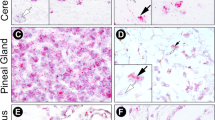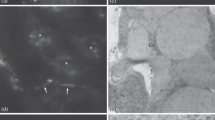Summary
The presence of dopamine-β-hydroxylase (DBH) and phenylethanol-amine-N-methyltransferase (PNMT) immunoreactivity in specific neurones of the snail Helix aspersa has been demonstrated. In addition, high performance liquid chromatography and electrochemical detection have revealed the presence of noradrenaline and adrenaline in the snail central nervous system, although the major catecholamine is dopamine. These results suggest that adrenaline, and perhaps noradrenaline, have transmitter or modulatory functions in the snail nervous system.
Similar content being viewed by others
References
Cuello AC (1983) Immunohistochemistry. Methods in neuroscience series. Vol 3. John Wiley, Chichester
Geffen LB, Livett BG, Rush RA (1969) Immunohistochemical localisation of protein components of catecholamine storage vesicles. J Physiol (Lond) 204:593–606
Gerschenfeld HM (1973) Chemical transmission in invertebrate central nervous systems and neuromuscular junctions. Physiol Rev 53:1–119
Glaizner B (1967) Pharmacological mapping of cells in the suboesophageal ganglia of Helix aspersa. In: J Salenki (ed) Neurobiology of invertebrates. Plenum Press New York, pp 267–284
Glaizner B (1968) Catecholamine receptors on neurones of Helix aspersa. J Physiol (Lond) 195:70–71
Guthrie PB, Neuhoff V, Osborne NN (1975) Dopamine, noradrenaline, octopamine and tyrosine-hydroxylase in the gastropod Helix pomatia. Comp Biochem Physiol 52C:109–111
Juorio AV, Killick SW (1972) Monoamines and their metabolism in some molluscs. Comp Gen Pharmacol 3:283–295
Leake LD, Walker RJ (1980) Invertebrate neuropharmacology. Blackie, Glasgow
Osborne NN, Cottrell GA (1970) Occurrence of noradrenaline and metabolites of primary catecholamines in the brain and heart of Helix. Comp Gen Pharmacol 1:1–10
Osborne NN, Nesselhut T (1983) Adrenaline: occurrence in the bovine retina. Neurosci Lett 39:33–36
Osborne NN, Nesselhut T, Nicholas DA, Patel S, Cuello AC (1982) Serotonin-containing neurones in vertebrate retinas. J Neurochem 39:1519–1528
Reis DJ, Benno RH, Tucker LW, Joh TH (1982) Quantitative immunocytochemistry of tyrosine hydroxylase in brain. In: V Chan-Palay, Palay SL (eds) Cytochemical methods in neuroanatomy. Alan Liss, New York, pp 205–228
Saavedra JM, Brownstein MJ, Carpenter DO, Axelrod J (1974) Octopamine: presence in single neurones of Aphysia suggests neurotransmitter function. Science 185:364–365
Walker RJ, Ramage AG, Woodruff GN (1972) The presence of octopamine in the brain of Helix aspersa and its action on specific snail neurones. Experientia 28:1173–1174
Author information
Authors and Affiliations
Rights and permissions
About this article
Cite this article
Osborne, N.N. Phenylethanolamine-N-methyltransferase and dopamine-β-hydroxylase immunoreactivity and the occurrence of noradrenaline and adrenaline in the nervous system of the snail Helix aspersa . Cell Tissue Res. 237, 605–608 (1984). https://doi.org/10.1007/BF00228445
Accepted:
Issue Date:
DOI: https://doi.org/10.1007/BF00228445




